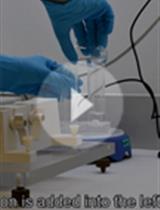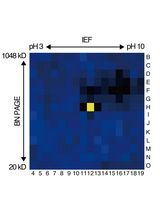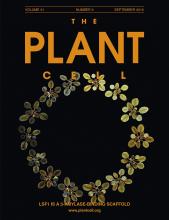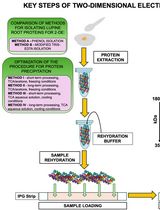- EN - English
- CN - 中文
Purification of Protein-complexes from the Cyanobacterium Synechocystis sp. PCC 6803 Using FLAG-affinity Chromatography
Cyanobacterium Synechocystis sp. PCC 6803 中蛋白混合物的标记亲和层析纯化方法
发布: 2020年05月20日第10卷第10期 DOI: 10.21769/BioProtoc.3616 浏览次数: 6061
评审: Amey RedkarHee-Kyung AhnDae Sung Kim

相关实验方案

从蓝藻集胞藻sp. PCC 6803中分离类囊体膜并利用CN-PAGE非变性聚丙烯酰胺凝胶电泳分析光合色素蛋白复合物
Josef Komenda [...] Tomas Zakar
2019年01月05日 8455 阅读

基于活性蛋白质组学和二维聚丙烯酰胺凝胶电泳(2D-PAGE)鉴定拟南芥细胞间隙液中的靶蛋白酶
Sayaka Matsui and Yoshikatsu Matsubayashi
2025年03月05日 1876 阅读
Abstract
Exploring the structure and function of protein complexes requires their isolation in the native state–a task that is made challenging when studying labile and/or low abundant complexes. The difficulties in preparing membrane-protein complexes are especially notorious. The cyanobacterium Synechocystis sp. PCC 6803 is a widely used model organism for the physiology of oxygenic phototrophs, and the biogenesis of membrane-bound photosynthetic complexes has traditionally been studied using this cyanobacterium. In a typical approach, the protein complexes are purified with a combination of His-affinity chromatography and a size-based fractionation method such as gradient ultracentrifugation and/or native electrophoresis. However, His-affinity purification harbors prominent contaminants and the levels of many proteins are too low for a feasible multi-step purification. Here, we have developed a purification method for the isolation of 3x FLAG-tagged proteins from the membrane and soluble fractions of Synechocystis. Soluble proteins or solubilized thylakoids are subjected to a single affinity purification step that utilizes the highly specific binding of FLAG-affinity resin. After an intensive wash, the captured proteins are released from the resin under native conditions using an excess of synthetic 3x FLAG peptide. The protocol allows fast isolation of low abundant protein complexes with a superb purity.
Keywords: Protein purification (蛋白质纯化)Background
Cyanobacteria have been used as the preferred model systems to study the biogenesis and function of photosynthetic protein complexes for decades. The photosynthetic apparatus in cyanobacteria is very similar to eukaryotic systems (algae and plants), but cyanobacteria have all the advantages of prokaryotic models, such as fast growth and small genomes that allow easy genetic manipulation and the use of standard tools of bacterial genetics. Particularly, Synechocystis sp. PCC 6803 (hereafter Synechocystis) is established as a favorite model organism in this field, mainly because it is transformable with high efficiency and integrates DNA by functional homologous recombination. Moreover, a glucose tolerant substrain of Synechocystis, which can proliferate using carbohydrate supplement, enables studying the function of photosynthetic genes by reverse genetics (Williams, 1988).
The biogenesis of photosystem II (PSII), a large membrane embedded pigment-protein complex responsible for photosynthetic water oxidation, has been studied intensively in Synechocystis (Nixon et al., 2010). The assembly of the PSII complex from individual subunits requires complicated machinery of many auxiliary (assembly) factors, which are typically involved in a certain assembly step (Komenda et al., 2012). A conventional approach for the analysis of PSII assembly complexes is using Synechocystis mutants lacking one or several PSII subunits. PSII biogenesis is then blocked at a particular step where the missing subunit would bind to an intermediate complex of the assembly process. In such mutants, the otherwise transient PSII pre-complexes can accumulate to a level that allows their detection and even purification, which has traditionally been achieved via His-tagged PSII (core) subunits (Dobáková et al., 2007 and 2009; Boehm et al., 2011 and 2012).
His-tag has several advantages: it is small enough to be easily introduced via a simple primer design, and it is relatively inexpensive to use. However, after His-affinity purification the preparations from Synechocystis often contain prominent contaminating proteins (Boehm et al., 2011 and 2012; Liu et al., 2011); therefore, additional purification steps are usually required to obtain the satisfactory quality for functional and structural studies. Additional purification steps may, however, compromise the yield and nativity of the complex of interest. Moreover, the levels of many protein complexes in the cell are simply too low for feasible multi-step purification protocols, PSII assembly intermediates are such an example. For these reasons, a fast, gentle, single-step purification method is highly desirable.
Affinity tags, based on biomolecular interactions offer superior specificity as compared to the general metal affinity of His-tag (Lichty et al., 2005). Large, proteinaceous tags such as small ubiquitin-like modifier (SUMO) or maltose binding protein (MBP) are well suited for the isolation of small soluble proteins due to their stable nature, which can even promote the solubility of the protein (Esposito and Chatterjee, 2006). However, for studying larger and potentially labile membrane-protein complexes, a less bulky tag with minimal interference on protein-protein interactions is preferable. Short peptide tags with high-affinity to proteins or antibodies seem to be the best suited for this purpose. One such tag is the short octapeptide called FLAG (DYKDDDDK; Hopp et al., 1988). Compared to His-, and several other tags, using FLAG-tag results in superior purity with little compromise in yield (Lichty et al., 2005). Moreover, because the elution of FLAG-tagged proteins is possible using a synthetic FLAG-peptide, the usage of disrupting chemicals, high ion concentrations or extreme pH can be avoided. Even though the price per mg purified protein of FLAG-affinity resin is approximately 50 times higher than that of Ni-NTA resin (Lichty et al., 2005); for the purification of labile and/or low-abundant complexes it can well worth the time and costs saved compared to optimizing multi-step purification procedures. Recently, FLAG-tag based approaches have been employed to purify pathogenic variants of the human Huntingtin protein from mammalian and insect cell lines (Harding et al., 2009), as well as the integral membrane Vo-part of the Pichia pastoris V-type ATPase (Li et al., 2017).
The FLAG-affinity purification protocol presented here is designed for the purification of proteins tagged with 3x FLAG epitope (DYKDDDDKDYKDDDDKDYKDDDDK). The protocol has been successfully used to resolve the roles of the PSII assembly factors Ycf39 (Knoppová et al., 2014), CyanoP (Knoppová et al., 2016), Pam68 (Bučinská et al., 2018) and RubA (Kiss et al., 2019); as well as pigment-protein complexes containing the chlorophyll-synthase (Chidgey et al., 2014), protoporphyrinogen oxidase (Skotnicová et al., 2018) and ferrochelatase enzymes (Pazderník et al., 2019). Although the method was originally developed for membrane-bound protein complexes, with minor modifications it can also be applied to soluble proteins.
Materials and Reagents
- Disposable semi-micro cuvettes (BRAND, catalog number: 759015 )
- 50 ml conical tubes (JET biofil, catalog number: CFT011500 )
- Round paint brush, ø 6 mm
- Pipette tips:
10 µl (Neptune, catalog number: 2340 )
200 µl (Eppendorf, catalog number: 00 30000870 )
1,000 µl (Eppendorf, catalog number: 00 30000927 ) - 1.5 ml microtubes (Deltalabs, catalog number: 4092.3N )
- 7 ml screw cap vials for cell lysis (BioSpec Products, catalog number: 3205 )
- Plastic chromatography column (Bio-Rad, catalog number: 7311550 )
- Synechocystis cells expressing a 3x FLAG-tagged protein
- BG-11 liquid medium and agar plates (Rippka et al., 1979)
- 100-200 µm glass microbeads (PRECIOSA ORNELA, crystal microbeads B 134)
- cOmplete protease inhibitor cocktail tablets (Sigma-Aldrich, catalog number: 11836145001 )
- (Optional) Microconcentrators with suitable cut-off filter (e.g., Amicon Ultra-0.5, Sigma-Aldrich)
- Liquid nitrogen
- Crushed ice
- Styrofoam box or equivalent for keeping ice
- Reverse osmosis (RO) water
- Deionized water (Merck, catalog number: 1167545000 )
- Methyl alcohol (PENTA, catalog number: 21240-11000 )
- n-dodecyl-β-D-maltoside (DDM; BioChemica, catalog number: A0819,0005 )
- ANTI-FLAG M2 Affinity Gel (Sigma-Aldrich, catalog number: A2220 )
- Proteus Clarification Mini Spin Column (Generon, catalog number: GEN-MSF500 )
- 3x FLAG peptide, 20 mg, > 85% purity (custom synthesis, Genscript, USA)
Notes:- An alternative is to purchase 3x FLAG peptide (Sigma-Aldrich, catalog number: F4799-4MG ), however, the custom synthesis is roughly 6 times cheaper.
- Prepare a 3 mg/ml solution in deionized water and store at -20 °C as 100-200 µl aliquots. Thawed peptide can be stored at 4 °C until use.
- 2-Morpholinoethanesulfonic acid (MES; AppliChem, catalog number: A0689,0250 )
- MgCl2·6H2O (PENTA, catalog number: 16330-31000 )
- Glycerol (PENTA, catalog number: 14550-11000 )
- CaCl2·2H2O (PENTA, catalog number: 16790-31000 )
- α-FLAG antibody (Merck, catalog number: F7425 )
- MES buffer (1 L) (see Recipes)
- 0.5 M MES-NaOH, pH 6.5 (250 ml) (see Recipes)
- 1 M MgCl2 (100 ml) (see Recipes)
- 1 M CaCl2 (100 ml) (see Recipes)
Equipment
- Temperature controlled growth facility equipped with an orbital shaker and a light source
- Laminar flow hood
- Metallic inoculation loop
- Gas burner
- 500 ml Erlenmeyer flasks
- Round culture flask (10 L)
- CimarecTM i Maxi magnetic stirrer (Thermo Fisher Scientific, catalog number: 50088143 ) and a magnetic stir bar
- Spectrophotometer (WPA S1200 Spectrawave)
- Centrifuges and rotors:
Centrifuge (Sigma Laborzentrifugen GmbH, model: Sigma 8KS , rotor: 12505-H)
Centrifuge (Sigma Laborzentrifugen GmbH, model: Sigma 3K30, rotors: 12155-H [+15 ml conical tube adapters, 13081] and 12158-H)
Centrifuge (Eppendorf, model: 5418)
Centrifuge (Eppendorf, model: 5415 R) - Centrifuge bottles:
500 ml (Nalgene, catalog number: 3141-0500 )
80 ml (Sigma Laborzentrifugen GmbH, catalog number: 15080)
27 ml (Sigma Laborzentrifugen GmbH, catalog number: 15032) - Deep freezer
- Regular freezer
- Mini-Beadbeater-16 (BioSpec Products, catalog number: 607 ) equipped with a 7 ml vial adapter (BioSpec Products, catalog number: 607 TC8)
- Vortex V-1 Plus (Biosan, catalog number: BS-010203-AAG )
- 1 ml Hamilton syringe (Hamilton, catalog number: 81330 )
- Automatic pipettes:
0.5-10 µl (Eppendorf, catalog number: 3120000020 )
10-100 µl (Eppendorf, catalog number: 3120000046)
100-1,000 µl (Eppendorf, catalog number: 3120000062) - Multi-Bio RS-24 rotator (Biosan, catalog number: BS-010117-AAG )
- Cold hood or cold room, 10 °C
- A retort stand and a ring clamp
- 25 ml glass beakers
Procedure
文章信息
版权信息
© 2020 The Authors; exclusive licensee Bio-protocol LLC.
如何引用
Koskela, M. M., Skotnicová, P., Kiss, �. and Sobotka, R. (2020). Purification of Protein-complexes from the Cyanobacterium Synechocystis sp. PCC 6803 Using FLAG-affinity Chromatography. Bio-protocol 10(10): e3616. DOI: 10.21769/BioProtoc.3616.
分类
植物科学 > 植物生物化学 > 蛋白质 > 分离和纯化
生物化学 > 蛋白质 > 分离和纯化
分子生物学 > 蛋白质 > 分离
您对这篇实验方法有问题吗?
在此处发布您的问题,我们将邀请本文作者来回答。同时,我们会将您的问题发布到Bio-protocol Exchange,以便寻求社区成员的帮助。
Share
Bluesky
X
Copy link










